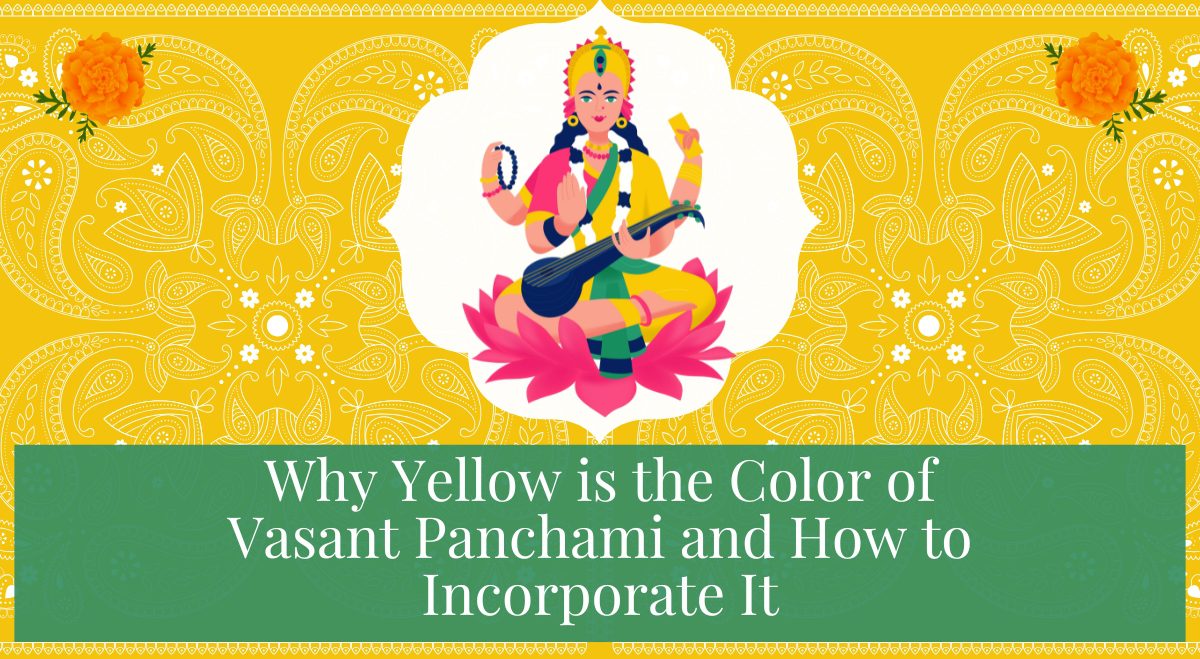Vasant Panchami is a bright spring festival where yellow is everywhere. This festival honors Saraswati, the goddess of knowledge and arts, and yellow is its main color. Yellow is important in every part of the celebration. But why is yellow so special for this festival? And how can we use yellow in our own Vasant Panchami celebrations? Let’s look at what yellow means and how we can use it in fun and meaningful ways during this festival.
What is the Symbolism of Yellow on Basant Panchami?
Yellow on Basant Panchami is not just a color; it’s a powerful symbol laden with meaning. This vibrant hue represents:
- The Arrival of Spring: Yellow symbolizes the blossoming mustard fields that carpet the Indian landscape during this season, signaling nature’s renewal.
- Knowledge and Wisdom: As Goddness Saraswati’s favored color, yellow represents the illumination of the mind through learning and creativity.
- Spiritual Awakening: The bright yellow mimics the sun’s rays, symbolizing the light of consciousness and spiritual enlightenment.
- Joy and Optimism: Yellow’s cheerful tone embodies the happiness and hope associated with new beginnings.
- Purity and Auspiciousness: In Hindu tradition, yellow is considered a sacred color, often used in religious ceremonies to invoke divine blessings.
The significance of yellow on Basant Panchami goes beyond mere aesthetics. It’s a visual reminder of the festival’s core values: the pursuit of knowledge, the celebration of creativity, and the embrace of new growth and possibilities.
How to Incorporate Yellow into Your Vasant Panchami Celebration
Using yellow in your Basant Panchami celebration can make it more special and meaningful. Here are some fun ways to add yellow to your festival:
1. Dress in Yellow Attire
Wearing yellow clothing is perhaps the most direct way to honor the tradition. Consider:
- Sarees or kurtas in shades ranging from pale lemon to deep mustard
- Yellow accessories like scarves, bangles, or turbans
- Traditional yellow tilak or forehead mark
2. Decorate Your Space
Transform your home or puja area into a yellow haven:
- Hang yellow marigold garlands
- Use yellow tablecloths or cushion covers
- Place vases filled with yellow flowers like daffodils or sunflowers
3. Prepare Yellow-Themed Foods
Incorporate yellow into your Basant Panchami feast:
- Cook yellow rice with turmeric and saffron
- Serve yellow sweets like kesar peda or besan ladoo
- Offer yellow fruits like bananas or mangoes
4. Create Yellow Art
Engage in creative activities that celebrate the color:
- Paint or draw using various shades of yellow
- Make yellow origami flowers or kites
- Create rangoli designs using yellow powder
5. Perform Yellow-Centric Rituals
Integrate yellow into your spiritual practices:
- Offer yellow flowers to Goddess Saraswati
- Light yellow candles during prayers
- Use yellow rice (akshat) for blessings
What is the Historical Significance of the Yellow Color in Vasant Panchami?
The association of yellow with Basant Panchami has deep historical roots. In ancient India, the arrival of spring coincided with the blooming of mustard flowers, painting the landscape in a sea of yellow. This natural phenomenon became intrinsically linked with the festival, symbolizing the earth’s awakening from winter’s slumber.
Moreover, yellow’s connection to Saraswati dates back to Vedic times. The goddess, often depicted wearing yellow garments, embodies the golden light of knowledge that dispels the darkness of ignorance. This imagery has been passed down through generations, reinforcing yellow’s status as the color of wisdom and learning.
The Psychological Impact of Yellow on the Festival of Vasant Panchami
The choice of yellow for Basant Panchami isn’t just traditional; it’s psychologically potent. Yellow is known to:
- Stimulate mental activity and memory
- Increase confidence and optimism
- Enhance communication and creativity
When we use yellow during Basant Panchami, we’re doing more than following tradition. We’re making a space that helps us learn, be creative, and grow spiritually, which is what the festival is all about.
Conclusion: Embracing the Golden Glow of Knowledge
When we celebrate Basant Panchami, let’s think of yellow as more than just a pretty color. It can remind us of the knowledge inside us, ready to grow and be shared. Using yellow in our clothes, food, decorations, and prayers helps us connect with what this special day means.
By using yellow, we’re not just following an old custom. We’re taking part in a tradition that values learning and new starts. As you get ready for Basant Panchami, think about fun ways to add yellow to your celebration.
We’d love to see how you use yellow in your Vasant Panchami celebrations. If you want, share photos in the comments. Your ideas might give others new ways to enjoy this tradition.
We hope your Basant Panchami is bright with learning and the joy of spring!

